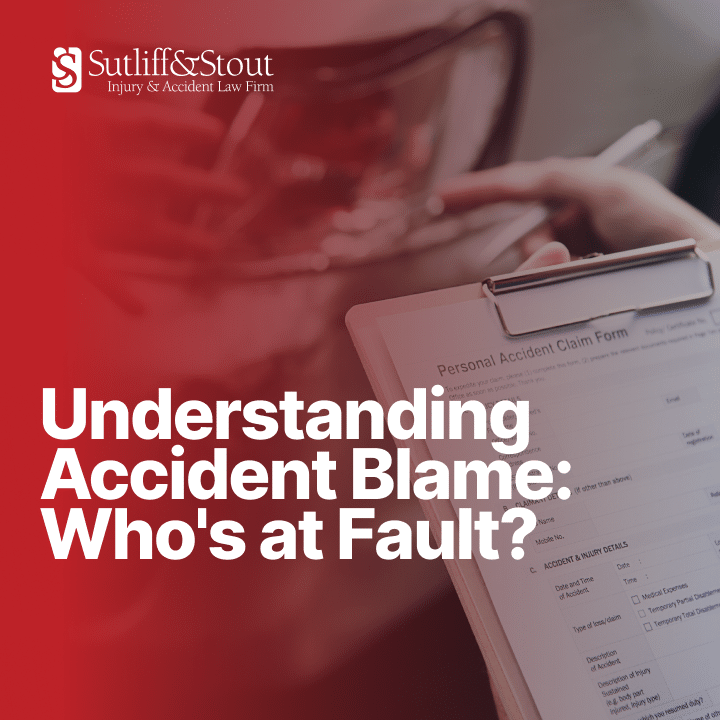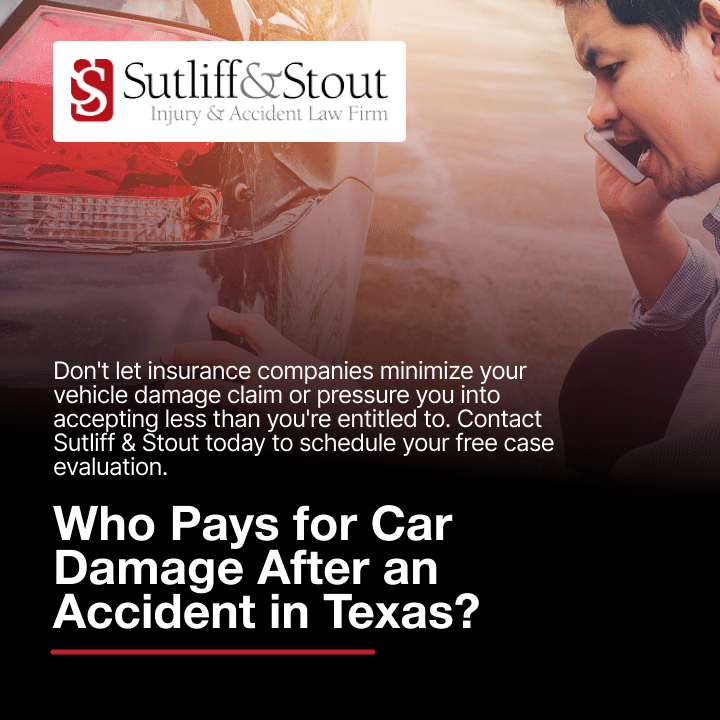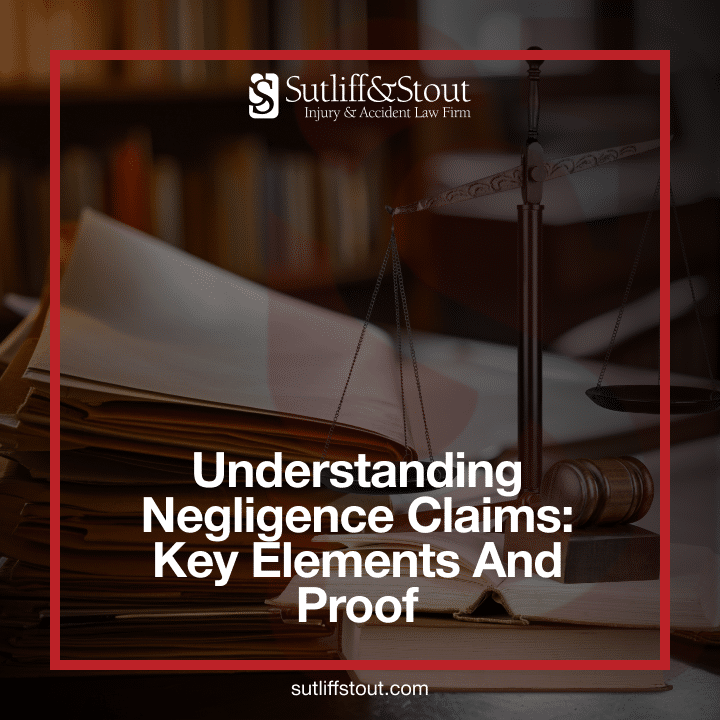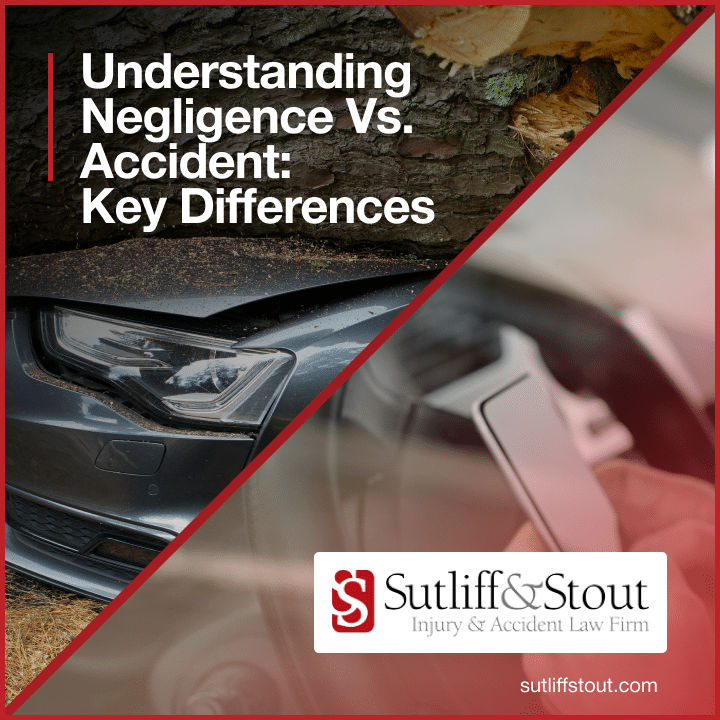
When you’re involved in a vehicle collision in Texas, determining who’s to blame isn’t just about pointing fingers—it’s a critical process with significant financial and legal implications. At Sutliff & Stout, we understand how confusing this process can be, especially when you’re dealing with injuries, vehicle damage, and insurance companies all at once.
What Is Accident Blame?
In legal terms, “accident blame” refers to the determination of which party’s negligence or wrongful actions caused an accident. In Texas, this concept is formally known as “fault” or “liability.” When someone is deemed “at fault,” it means they’re legally responsible for the accident and typically liable for resulting damages.
Why Is Determining Fault Important?
Determining fault is crucial because Texas follows a “modified comparative negligence” rule with a 51% bar. This means:
- If you’re less than 51% at fault, you can recover damages, reduced by your percentage of fault
- If you’re 51% or more at fault, you cannot recover any damages
For example, if you suffer $10,000 in damages and are found 30% at fault, you can recover $7,000 (the total damages minus your 30% responsibility). But if you’re found 51% at fault, you recover nothing—regardless of how severe your injuries might be.
Additionally, fault determination affects:
- Who pays for vehicle repairs
- Who covers medical expenses
- Whether you can file a lawsuit
- Future insurance premium rates
How Is Fault Determined in Vehicle Accidents?
In Texas, determining fault in an auto accident involves several factors and entities working together to establish who bears responsibility. Understanding this process is essential for protecting your rights and ensuring fair treatment by insurance companies. Let’s examine the key elements involved in fault determination:
Police Reports
When law enforcement responds to an accident in Texas, they create an official crash report (Form CR-3). While these reports don’t explicitly assign legal fault, they often include:
- Officer observations about the accident scene
- Statements from drivers and witnesses
- Citations issued to any drivers
- Diagrams of the collision
- Preliminary assessments of contributing factors
Role in Insurance Assessments
Police reports carry significant weight with insurance companies. A citation for a traffic violation in the report often leads insurers to assign fault to the cited driver.
Insurance Investigations
After an accident, each insurance company conducts its own investigation, which typically includes:
- Reviewing the police report
- Examining vehicle damage
- Taking statements from involved parties
- Analyzing accident scene evidence
- Consulting surveillance footage if available
Criteria for Fault Determination
Insurance adjusters in Texas typically consider:
- Traffic law violations
- Right-of-way rules
- Vehicle positioning and damage patterns
- Witness statements
- Driver statements
- Road and weather conditions
Traffic Laws and Violations
Texas transportation laws establish “rules of the road” that all drivers must follow. Violating these laws often creates a presumption of fault.
Specific Violations Indicating Fault
Certain violations nearly always result in fault determination:
- Running red lights or stop signs
- Exceeding speed limits
- Improper lane changes
- Following too closely
- Driving while intoxicated
- Texting while driving (illegal in Texas since 2017)
- Failing to yield right-of-way
Common Types of Accidents and Fault
Different types of vehicle collisions often follow predictable patterns when it comes to fault determination. Texas courts and insurance companies typically analyze these accidents based on established precedents and traffic law applications. Understanding how fault is commonly assigned in these scenarios can help you better navigate your own accident case:
Rear-End Collisions
Typically the Rear Driver’s Fault
In Texas, the driver who hits another vehicle from behind is almost always considered at fault. This is because Texas law requires drivers to maintain a safe following distance and be prepared to stop.
Exceptions can occur when:
- The front vehicle reverses suddenly
- The front vehicle’s brake lights are non-functional
- The front driver stops abruptly without cause
Rear-end accidents are among the most common collision types in Texas, particularly in heavily congested areas like Houston, Dallas, and Austin. Even in these seemingly straightforward cases, having proper legal representation can make a significant difference in the compensation you receive, especially when dealing with injuries like whiplash that aren’t immediately apparent.
T-Bone Accidents
Fault Depends on Right-of-Way Violations
T-bone (side-impact) collisions typically occur at intersections and fault usually goes to the driver who failed to yield right-of-way. Determining factors include:
- Traffic signal status
- Stop sign presence
- Right-of-way rules at uncontrolled intersections
- Witness statements about which vehicle entered the intersection first
T-bone accidents frequently result in severe injuries due to the limited protection on vehicle sides. In Texas, these accidents commonly occur at busy intersections where drivers fail to yield or misjudge traffic signal timing. The complexity of these cases often requires thorough investigation, as the consequences can be life-altering for those involved.
Multi-Vehicle Pile-Ups
Complex Fault Determination
Chain-reaction accidents on Texas highways often involve complex fault determinations. In these cases:
- Multiple drivers may share percentages of fault
- The initial collision is analyzed separately from subsequent impacts
- Each driver’s actions are evaluated individually
- Expert accident reconstruction may be necessary
Texas highways, particularly I-10, I-35, and I-45, see a disproportionate number of multi-vehicle accidents due to high traffic volume and variable speed conditions. These complex cases require experienced legal representation to protect your interests, as insurance companies often attempt to shift blame to minimize their liability in these costly accidents.
Jurisdictional Impact on Fault Determination
Texas is unique in how it handles fault compared to some other states:
- Texas is an “at-fault” state, not a “no-fault” state, meaning the party responsible for the accident is liable for damages
- Texas uses the 51% bar rule for comparative negligence, which differs from states with pure comparative negligence or contributory negligence systems
- Local traffic laws may supplement state regulations in determining fault
Insurance Companies’ Role in Fault Determination
It’s important to understand that insurance companies have financial incentives to minimize their payouts. This can lead to:
- Attempts to assign greater fault percentages to the other driver’s policyholder
- Quick settlement offers before the full extent of damages is known
- Selective interpretation of evidence
In Texas, insurers must follow the Texas Insurance Code and related regulations when investigating and settling car accident claims, but they still advocate for their financial interests.
Disputing Fault in an Accident
Being assigned fault for an accident doesn’t mean you have to accept that determination as final. Texas law provides avenues to contest fault findings, and many initially unfavorable determinations are successfully challenged with the right approach and evidence. Taking prompt action is critical—Texas has a two-year statute of limitations for personal injury claims, giving you limited time to build your case.
Gathering Evidence
Photos, Witness Statements, and Reports
To contest an unfavorable fault determination in Texas, collect:
- Photographs of all vehicle damage
- Photos of the accident scene, including skid marks and debris
- Contact information from all witnesses
- Video footage from nearby businesses or traffic cameras
- A copy of the official Texas crash report
- Medical records documenting injuries
The evidence gathering process should begin immediately after an accident, if possible. Texas’s comparative negligence system means that even small details can significantly impact your recovery amount. Remember that evidence tends to disappear quickly—skid marks fade, witnesses become difficult to locate, and surveillance footage may be overwritten—making prompt action essential to protecting your claim.
Hiring a Car Accident Attorney
At Sutliff & Stout, our experienced car accident attorneys have a proven track record of successfully challenging unfair fault determinations throughout Houston, Dallas, and across Texas. Our team brings several crucial advantages to your case:
- We conduct thorough independent investigations rather than relying on potentially flawed insurance company findings
- We maintain relationships with top accident reconstruction experts who can provide scientific analysis of collision dynamics
- Our attorneys analyze physical evidence that insurance companies may overlook or misinterpret
- We personally interview all witnesses, often uncovering critical testimony not included in police reports
- Our legal team carefully reviews police reports for inconsistencies or procedural errors that may impact fault determinations
- With deep expertise in Texas transportation laws and local traffic regulations, we understand nuances that general practice attorneys might miss
What truly sets Sutliff & Stout apart is our comprehensive approach to accident cases. We don’t just challenge fault determinations—we build complete cases that account for all aspects of your damages, including future medical needs, lost earning capacity, and non-economic damages like pain and suffering. Our attorneys have recovered millions of dollars for clients who were initially blamed for accidents they didn’t cause.
Maximize Your Compensation – Start With a Free Consultation!
If you’ve been involved in an accident in Texas where fault is disputed, don’t face the insurance companies alone. The experienced car accident attorneys at Sutliff & Stout can help ensure you’re not unfairly blamed and fight for the compensation you deserve.
Our team understands the nuances of Texas fault laws and has successfully contested countless incorrect fault determinations. Contact us today for a free, no-obligation consultation to discuss your case and learn how we can help protect your rights and financial future.
- Understanding Wrongful Death Compensation in Texas: Types and Eligibility - June 15, 2025
- Understanding Car Accident Court Cases - June 2, 2025
- Who Pays for Car Damage After an Accident in Texas? - May 20, 2025








 (713) 405-1263
(713) 405-1263  550 Post Oak Blvd, Suite 530
550 Post Oak Blvd, Suite 530